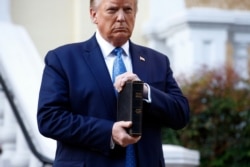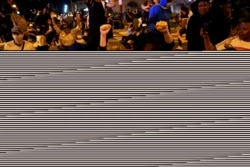President Donald Trump is threatening to use the military to end “the riots and lawlessness” that have broken out across the United States following the death of a black man in police custody, prompting harsh criticism from political opponents including likely presidential nominee Joe Biden, who expressed concern “for the very soul of our country.”
In a nationally televised address in the White House Rose Garden, the president warned that “if a city or state refuses to take the actions necessary to defend the life and property of their residents, then I will deploy the United States military and quickly solve the problem for them.”
The comment was an apparent reference to the 1807 Insurrection Act, which allows presidents to quell lawlessness during emergencies. The law was most recently used in 1992 amid rioting in Los Angeles after another African-American man, Rodney King, was beaten by police.
Trump said he was “mobilizing all available federal resources, civilian and military, to stop the rioting and looting, to end the destruction and arson, and to protect the rights of law-abiding Americans, including your Second Amendment rights.” The Second Amendment of the U.S. Constitution protects the rights of all American citizens to own firearms.
Just before the president spoke, reporters awaiting his remarks in the Rose Garden could hear loud explosions from volleys of tear gas fired around Lafayette Park, where riot police holding shields aloft pushed back peaceful demonstrators. Rubber bullets were also fired, and police on horseback were brought in to clear the area.
The movement by law enforcement came less than a half-hour before a 7 p.m. curfew went into effect for Washington.
The action cleared the way — but not the smell of the tear gas — around St. John’s Church, a block north of the White House, to which Trump walked just minutes after the curfew went into effect. The historic Episcopal Church, known in Washington as “the church of the presidents,” suffered minor damage Sunday evening when a small fire was set in its basement.
In front of the boarded-up church, Trump held up a Bible, referred to the United States as the “greatest country in the world,” and said, “we’re going to keep it safe.”
Then Trump walked back to the White House surrounded by heavy security.
In his Rose Garden remarks, Trump said his “first and highest duty as president is to defend the great country and the American people. I swore an oath to uphold the laws of our nation, and that is exactly what I will do. All Americans are rightly sickened and revolted by the brutal death of George Floyd. My administration is fully committed that for George and his family, justice will be served. He will not have died in vain.
“But we cannot allow the righteous prize and peaceful protesters to be drowned out by an angry mob. The biggest victims of the rioting are peace loving citizens in our poorest communities, and as their president, I will fight to keep them safe. I will fight to protect you. I am your president of law and order and an ally of all peaceful protesters.”
Hours after the president’s speech and his appearance in front of St. John’s, Biden, the president’s presumptive Democratic opponent in this year’s November presidential election, denounced Trump’s actions on his Twitter feed. “He's using the American military against the American people,” Biden wrote. “He tear-gassed peaceful protesters and fired rubber bullets. For a photo.”
“For our children, for the very soul of our country, we must defeat him.”
Bishop Mariann Budde, the leader of the Episcopal Diocese of Washington, also expressed her disapproval of Trump’s actions on her Twitter feed. “Tonight President [sic] just used a Bible and a church of my diocese as a backdrop for a message antithetical to the teachings of Jesus and everything that our church stands for. To do so, he sanctioned the use of tear gas by police officers in riot gear to clear the church yard,” Bishop Budde wrote.
“President Trump’s decision to invoke the Insurrection Act, and his inflammatory rhetoric, proves that he cannot lead us through these tumultuous times and unite the country. Instead, he has decided to rely on the use of force to address those who he views as a threat,” Congressman Adam Smith, chairman of the House Armed Services Committee, said in a statement.
The president, according to Defense Department officials, has ordered the Army to deploy an active duty military police battalion for Washington, the single jurisdiction where the military can do so without first consulting the governor of a state.
National Guard forces
All 1,200 National Guard forces in the nation’s capital have been mobilized, and five states were quickly sending between 600 and 800 additional Guard troops, some armed with lethal weapons, according to officials.
Additional U.S. active duty troops, including military police and engineering units, have been placed on standby outside the District of Columbia but are poised to move in if necessary, officials say.
Late Monday night, a U.S. Army Black Hawk helicopter flew low over the rooftops of Washington’s historic Chinatown district in a “show of force” maneuver, sending protesters scattering to avoid the dust and debris kicked up by the helicopter’s rotors, which also snapped the branches off trees.
Trump’s action is being viewed as his most overt flexing of authoritarian muscle since he took office 3½ years ago.
“We are teetering on a dictatorship,” Don Lemon said on the cable news network, CNN, immediately following the president’s remarks. “I think the president is playing a very, very dangerous game here.”
The president has repeatedly referred to CNN as “fake news” and frequently characterizes the mainstream U.S. media as “enemies of the people.”
Trump calls governors 'weak'
Earlier Monday, governors received a lecture from Trump, the defense secretary and the attorney general, exhorting them to get tough with unruly protesters on the streets of America’s cities.
In a conference call with governors about the violent demonstrations across the country, the leaders of the states were sharply criticized by the president.
"Most of you are weak,” the president told them, according to an audio recording of the call. “You have to dominate. If you don’t dominate, you’re wasting your time. They’re going to run over you, you’re going to look like a bunch of jerks.”
Trump is facing criticism for not adopting the traditional presidential role of “consoler-in-chief" since the death of African-American George Floyd while in police custody in Minneapolis, prompted a national outpouring of agony and anger.
The president, instead, has spent time on Twitter attacking Biden, other Democratic politicians and lumping them in with the far-left radicals he blames for the violence in recent days.
The call with Trump on Monday was “deeply disturbing,” said Michigan Governor Gretchen Whitmer, a Democrat.
“Instead of offering support or leadership to bring down the temperature at protests, President Trump told governors to ‘put it down’ or we would be ‘overridden,’” she said in a statement.
About half of the governors have already activated National Guard units to assist law enforcement in quelling the unrest. But more members of the guard are needed on the streets, according to the president.
“They’re ready, willing and able. They want to fight for the country,” Trump said to the governors. “I wish we had an occupying force in there.”
Los Angeles, specifically, is “not using the greatest resource you can use,” Trump said of the military forces under state control.
Trump and the White House are blaming the violence on a loose coalition of far-left activists, known as “antifa” (for anti-fascist), whose members campaign against what they view as acts of authoritarianism, homophobia, racism or xenophobia.
The Republican president warned on Twitter earlier that “when the looting starts, the shooting starts.” Trump later denied that the phrase was a warning that vandals would be shot and said he did not know it had been used prominently by Miami’s police chief in 1967 in response to violent crime in black neighborhoods.
“It’s a movement that if you don’t put it down it’ll get worse and worse,” said Trump to the governors Monday. “These are radicals and they are anarchists.”
White House Press Secretary Kayleigh McEnany asked at a White House news briefing about the Michigan governor’s reaction, said she does not understand why Whitmer would be disturbed by the president telling governors to do their jobs.
Another Democrat, Governor J.B. Pritzker of Illinois, told the president, “I’ve been extraordinarily concerned about the rhetoric that’s been used by you. It’s been inflammatory.”
The president replied: “I don’t like your rhetoric much either,” criticizing Pritzker's response to the coronavirus outbreak. “I think you could've done a much better job, frankly.”
Attorney General William Barr told the governors, “we have to control the streets … and that requires a strong presence.”
Professional instigators are looking to move from strong to weak states to cause mayhem, Barr said, adding this was based on intelligence reports.
“They’re all looking for weak spots,” Trump said. “You got to arrest these people” and put them away for years. “These are terrorists. They’re antifa and radical left.”
Trump specifically called on New York City and Philadelphia “to toughen up.”
Trump said the initial response in Minnesota was “weak and pathetic,” but Minnesota Governor Tim Walz, a Democrat, deserved praise for deploying the National Guard, which knocked down demonstrators “like bowling pins -- a beautiful thing to watch.”
On the conference call, Defense Secretary Mark Esper told the governors that “the sooner you mass and dominate the battle-space, the quicker that this dissipates.”
A week after Floyd, 46, died in police custody after a white police officer was filmed pressing his knee into Floyd's neck for more than 8 minutes, peaceful demonstrations have been overshadowed by urban violence across America. Businesses have been vandalized and looted, public monuments damaged and law enforcement officers firing rubber bullets and tear gas at protesters, some of whom have pelted police with bricks, firecrackers and bags of bodily fluids.
Thousands of people were arrested across the United States during demonstrations Saturday and Sunday.
California on Monday ordered state government buildings closed in downtown areas.
In Chicago, two people were killed during demonstrations on Monday in the Chicago suburb of Cicero and 60 people were arrested, the Associated Press reported.
Washington, D.C., Mayor Muriel Bowser moved up the nightly curfew by four hours, to 7 p.m.
McEnany said of Trump, “He does understand that pain” of the lawful demonstrators.” She added, “it’s really a shame” that radicals on the streets are dampening the message of the peaceful protesters.










